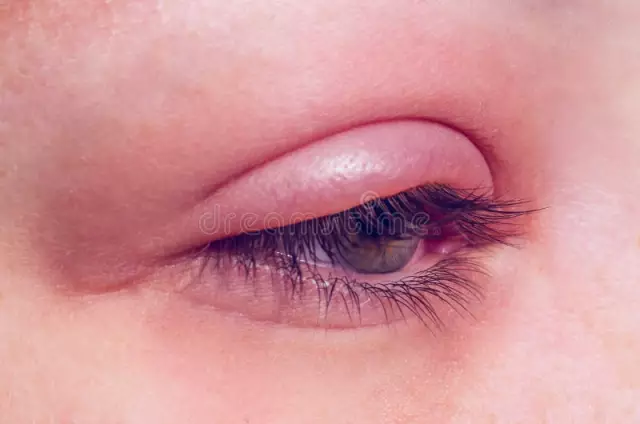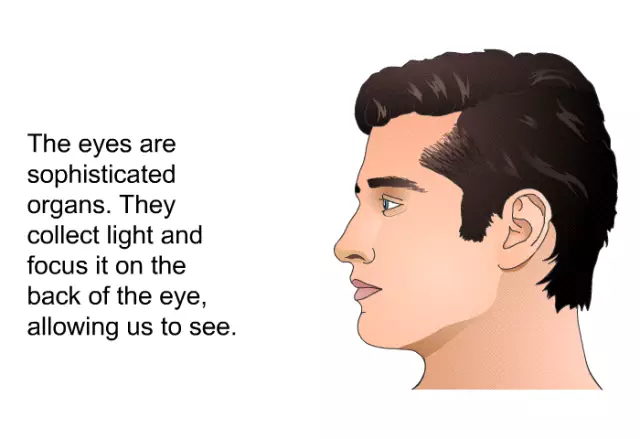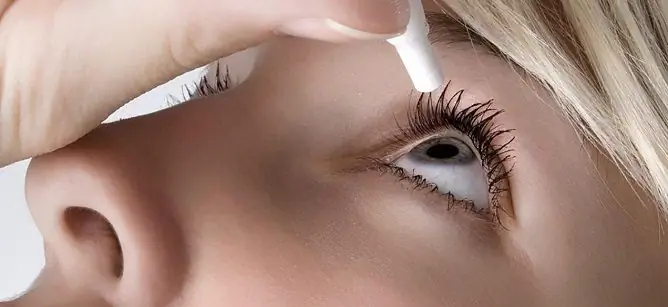- Author Rachel Wainwright [email protected].
- Public 2023-12-15 07:39.
- Last modified 2025-11-02 20:14.
Visallergol
Visallergol: instructions for use and reviews
- 1. Release form and composition
- 2. Pharmacological properties
- 3. Indications for use
- 4. Contraindications
- 5. Method of application and dosage
- 6. Side effects
- 7. Overdose
- 8. Special instructions
- 9. Application during pregnancy and lactation
- 10. Use in childhood
- 11. With renal failure
- 12. With liver failure
- 13. Use in the elderly
- 14. Drug interactions
- 15. Analogs
- 16. Terms and conditions of storage
- 17. Terms of dispensing from pharmacies
- 18. Reviews
- 19. Price in pharmacies
Latin name: Vizallergol
ATX code: S01GX09
Active ingredient: olopatadin (Olopatadine)
Manufacturer: Sentiss Pharma Pvt. Ltd. (Sentiss Pharma Pvt. Ltd) (India)
Description and photo update: 2019-11-07
Prices in pharmacies: from 364 rubles.
Buy

Visallergol is an ophthalmic antiallergic agent.
Release form and composition
Dosage form - eye drops 0.2%: a clear solution from colorless to light yellow (2.5 ml each in polyethylene bottles equipped with a dropper stopper and a screw cap with first opening control, in a cardboard box 1 bottle and instructions for the use of Visallergol).
Composition of 1 ml solution:
- active ingredient: olopatadin (in the form of hydrochloride) - 2 mg;
- excipients: water for injection, disodium edetate, sodium hydrogen phosphate anhydrous, povidone K-29/32, sodium chloride, benzalkonium chloride, sodium hydroxide and / or hydrochloric acid.
Pharmacological properties
Pharmacodynamics
Visallergol contains olopatadin as an active ingredient - a powerful selective agent with an antihistamine effect, which is due to several different mechanisms of action.
The drug exhibits antagonistic properties against histamine, which is the main mediator of allergic reactions. Prevents histamine-induced release of inflammatory cytokines in the epithelial cells of the conjunctiva. In vitro studies suggest that the release of anti-inflammatory mediators is inhibited by mast cells in the conjunctiva.
When the nasolacrimal ducts are passable, instillation of olopatadin into the conjunctival sac can reduce the severity of nasal symptoms associated with seasonal allergic conjunctivitis.
Olopatadin does not have a clinically significant effect on the diameter of the pupil.
Pharmacokinetics
When applied topically by instillation into the conjunctival sac, olopatadin undergoes systemic absorption. However, it reaches lower plasma concentrations: they are in the range from <0.5 ng / ml (the level is below quantitative determination) to 1.3 ng / ml, which is 50-200 times less than those when therapeutic doses of olopatadine are taken orally.
The half-life (T 1/2) in the study of oral dosage forms of olopatadin was 8-12 hours. The drug is excreted mainly by the kidneys in the urine: 60-70% - unchanged, in small amounts - in the form of metabolites (mono-desmethyl and n -oxide).
With severe renal failure [CC (creatinine clearance) 13 ml / min], the plasma concentration of olopatadine increases 2.3 times. However, given the low plasma content of the drug when applied topically in ophthalmology, dose adjustment of Visallergol for patients with impaired renal function is not required.
In patients on hemodialysis after taking a dose of 10 mg olopatadine, the plasma concentration of the drug on the day of the session was lower than on the days without dialysis. This indicates the possible elimination of olopatadine by hemodialysis.
In case of impaired hepatic function, a change in the dosage regimen is not required, since the hepatic elimination pathway for olopatadin is not the main one.
In young patients (mean age 21 years) and elderly people (mean age 74 years), comparative studies of the pharmacokinetics of olopatadine taken orally at a dose of 10 mg did not reveal significant differences in the plasma concentrations of the drug, in its binding to plasma proteins and excretion parameters. …
Indications for use
Visallergol eye drops are used to eliminate itching in the eyes caused by allergic conjunctivitis.
Contraindications
- children under 3 years old;
- the period of pregnancy and breastfeeding;
- known hypersensitivity to any component in Visallergol.
Visallergol, instructions for use: method and dosage
Eye drops Visallergol is instilled into the conjunctival sac of the affected eye 1 drop 1 time per day.
The duration of treatment is determined by the period of exposure to the allergen, it can be up to 4 months.
Side effects
In clinical trials, 1680 patients took part, who dripped Visallergol 1-4 drops per day for a period of up to 4 months. The drug was used both in monotherapy and in combination with loratadine (at a dose of 10 mg). The overall incidence of adverse reactions was about 4.5%, but only 1.6% of patients required discontinuation of treatment. According to the results of clinical studies, there were no serious side effects, both on the part of the organ of vision and on the part of the body as a whole. The most common (0.7%) was eye pain.
The following adverse events have been reported in clinical and post-marketing studies (classified by frequency as follows:> 1/10 - very common; from> 1/100 to 1/1000 to 1/10 000 to <1/1000 - rarely; <1 / 10,000 - very rare; according to the available data, it is not possible to assess the frequency of occurrence of an adverse reaction - an unknown frequency)
- phenomena on the part of the organ of vision: often - unusual sensations or pain in the eye, irritation or dry eye syndrome; infrequently - discomfort, itching and feeling of a foreign body in the eye, lacrimation, discharge from the eyes, decreased visual acuity / blurred vision, keratitis (including point), photophobia, blepharospasm, conjunctival disorders, conjunctival folliculosis, corneal defect / erosion, accumulation of coloring pigment in the area of the corneal defect during diagnostic tests, conjunctival injection, edema / erythema of the eyelids or other disorders of the eyelids; unknown frequency - impaired visual function, conjunctivitis, mydriasis, conjunctival / corneal edema, crusts on the edges of the eyelids;
- infectious disorders: infrequently - rhinitis;
- effects from the nervous system: often - dysgeusia, headache; infrequently - hypesthesia, dizziness; unknown frequency - drowsiness;
- phenomena from the immune system: unknown frequency - facial swelling, hypersensitivity reactions;
- disorders of the respiratory system: often - dry nose; unknown frequency - sinusitis, dyspnea;
- effects from the gastrointestinal tract: unknown frequency - nausea, vomiting;
- phenomena on the part of the skin and subcutaneous adipose tissue: infrequently - dryness or burning sensation of the skin, contact dermatitis; unknown frequency - erythema, dermatitis;
- others: often - increased fatigue; very rarely in patients with significant corneal damage - corneal calcification; unknown frequency - feeling unwell, asthenia.
Overdose
There have been no reports of the development of toxic disorders with accidental instillation of an excessive dose of Visallergol or unintentional ingestion of a large amount of the drug.
There are no specific recommendations for therapeutic tactics. Overdose treatment is symptomatic.
special instructions
Visallergol is not intended to relieve conjunctival injection caused by contact lenses.
The drops contain benzalkonium chloride as a preservative - it can be adsorbed by soft contact lenses and provoke the development of eye irritation. In this regard, it is recommended to remove the lenses before burying the eyes and install them at least 15 minutes later.
According to some studies, benzalkonium chloride can cause the development of punctate keratopathy and / or toxic ulcerative keratopathy.
In order to prevent microbial contamination of the drug, when instilling Visallergol, you should not touch the tip of the dropper to the eyes, the skin of the periorbital region and other surfaces. After each use of the eye drops, the cap must be screwed on tightly.
If necessary, you can prescribe Visallergol in conjunction with other local ophthalmic drugs, but you should observe at least a 5-minute interval between their uses.
With frequent and / or prolonged use of eye drops in patients with corneal lesions or dry eye syndrome, the condition of the conjunctiva should be carefully monitored.
Despite topical application, olopatadine can be absorbed into the bloodstream and cause systemic reactions. With the development of severe symptoms of hypersensitivity, drug treatment should be discontinued.
Studies on the effect of Visallergol on fertility when applied topically in ophthalmology have not been conducted.
Influence on the ability to drive vehicles and complex mechanisms
In general, Visallergol does not significantly affect the speed of reactions and the ability to concentrate. However, in some patients, immediately after instillation of the drug, temporary blurred vision is possible. In this case, for some time after instilling the eyes (until the clarity of visual perception is restored), one should refrain from driving and performing potentially dangerous work.
Application during pregnancy and lactation
Information on the use of olopatadine in the form of eye drops in pregnant women is lacking or limited. According to animal studies, with systemic use, the drug has a toxic effect on reproductive function. Therefore, Visallergol is contraindicated during pregnancy. Women of reproductive age should use reliable methods of contraception during treatment.
In animal studies, olopatadine was excreted in breast milk. Due to the risk of developing adverse reactions in infants, Visallergol is contraindicated during lactation.
Pediatric use
Eye drops are not prescribed for children under 3 years old, since there is no experience with their use in this age group. At the age of 3 years, Visallergol is used in doses similar to those for adults.
With renal failure
When applied topically, olopatadine in plasma concentration is determined in very small quantities and, accordingly, is also excreted by the kidneys, therefore, dose adjustment of Visallergol for patients with impaired renal function is not required.
With liver failure
The hepatic elimination pathway for olopatadin is not the main one, therefore, a change in the dosage regimen of Visallergol is not required for violations of hepatic function.
Use in the elderly
In elderly patients, Visallergol is used in usual doses.
Drug interactions
Under in vitro conditions, no inhibition of metabolic reactions mediated by the following cytochrome P450 isoenzymes was found: 3A4, 1A2, 2C9, 2C8, 2D6, 2C19, 2E1.
Studies on possible drug interactions with the combined use of olopatadine with other drugs / agents have not been conducted.
According to the available data, the development of metabolic reactions with the simultaneous use of other drugs is unlikely.
Analogs
Analogs of Visallergol are Allergodil, Dipolkrom, Kromitsil-SOLOpharm, Kromohexal, Kromoglin, Lekrolin, Olopatallerg, Opatanol, Hi-Krom, Epinepta.
Terms and conditions of storage
Keep out of reach of children at temperatures from +2 to +25 ° C. Do not freeze.
Shelf life is 2 years.
After opening the bottle, the drops should be used within 28 days.
Terms of dispensing from pharmacies
Dispensed by prescription.
Reviews about Visallergol
According to reviews, Visallergol is an effective antihistamine ophthalmic agent that eliminates redness and itching in the eyes with allergic conjunctivitis.
Of the side effects, short-term reactions are mentioned immediately after the instillation of Visallergol, which disappear within literally one minute.
The cost of the drug is generally assessed as quite high.
Price for Visallergol in pharmacies
The approximate price for Visallergol (eye drops 0.2%), depending on the region of sale and the pharmacy chain, may be 358-560 rubles. for 1 bottle of 2.5 ml.
Visallergol: prices in online pharmacies
|
Drug name Price Pharmacy |
|
Visallergol 0.2% eye drops 2.5 ml 1 pc. 364 RUB Buy |
|
Visallergol eye drops 0.2% fl. 2,5ml 473 r Buy |

Maria Kulkes Medical journalist About the author
Education: First Moscow State Medical University named after I. M. Sechenov, specialty "General Medicine".
Information about the drug is generalized, provided for informational purposes only and does not replace the official instructions. Self-medication is hazardous to health!






